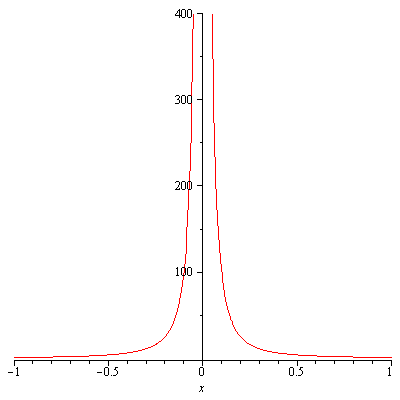When we defined the definite integral $\int_a^b f(x)dx$, it was assumed that the limits $a$ and $b$ of the integral are finite and the integrand $f(x)$ is continuous on the closed interval $[a,b]$. Even if these assumptions are not satisfied, we can still consider a notion of integral extended from the definite integral (the Riemann integral). This extended integral is called the improper integral.
Infinite Limits
A definite integral, in which one or both limits of integration are infinite, is defined by the following: \begin{align*}\int_a^\infty f(x)dx&=\lim_{t\to\infty}\int_a^tf(x)dx\\\int_{-\infty}^b f(x)dx&=\lim_{t\to -\infty}\int_t^bf(x)dx\end{align*} The improper integrals are said to be convergent if the corresponding limit exists. Otherwise, divergent.
If both $\int_{-\infty}^a f(x)dx$ and $\int_a^\infty f(x)dx$ are convergent, we define $$\int_{-\infty}^\infty f(x)dx=\int_{-\infty}^a f(x)dx+\int_a^\infty f(x)dx$$
Examples:
- $\int_{-\infty}^0e^xdx=\lim_{t\to -\infty}\int_t^0 e^xdx=\lim_{t\to -\infty}(1-e^t)=1$.
- $\int_2^\infty\frac{dx}{x}=\lim_{t\to \infty}\int_2^t\frac{dx}{x}=\lim_{t\to \infty}(\ln t-\ln 2)=\infty$.
- $\int_{-\infty}^0\frac{1}{1+x^2}dx=\lim_{t\to -\infty}\int_t^0\frac{1}{1+x^2}dx=\lim_{t\to -\infty}(-\tan^{-1}t)=\frac{\pi}{2}$.
- $\int_0^\infty\frac{1}{1+x^2}dx=\lim_{t\to\infty}\int_0^t\frac{1}{1+x^2}dx=\lim_{t\to\infty}(\tan^{-1}t)=\frac{\pi}{2}$.
- $\int_{-\infty}^\infty\frac{1}{1+x^2}dx=\int_{-\infty}^0\frac{1}{1+x^2}dx+\int_0^\infty\frac{1}{1+x^2}dx=\frac{\pi}{2}+\frac{\pi}{2}=\pi$.
Remarks:
- $\int_{-\infty}^\infty f(x)dx$ can be also defined by the double limit $$\int_{-\infty}^\infty f(x)dx=\lim_{b\to\infty\\a\to -\infty}\int_a^b f(x)dx$$
- $\int_{-\infty}^\infty\frac{2x}{1+x^2}dx$ is divergent as $\int_{-\infty}^0\frac{2x}{1+x^2}dx=-\infty$ and $\int_0^\infty\frac{2x}{1+x^2}dx=\infty$. On the other hand, $$\lim_{a\to\infty}\int_{-a}^a\frac{2x}{1+x^2}dx=0$$ This is called the Cauchy principal value of the integral $\int_{-\infty}^\infty\frac{2x}{1+x^2}dx$ and is denoted by $$\mathrm{p.v.}\int_{-\infty}^\infty\frac{2x}{1+x^2}dx$$ The Cauchy principal value is a method of assigning values to certain ill-defined improper integrals. We will not, however, be considering the Cauchy principal value here.
Discontinuous Integrand
If $f(x)$ is continuous for all values of $x$ in the domain $a\leq x\leq b$ except $x=b$ or $x=a$, $\int_a^b f(x)dx$ is defined by \begin{equation}\label{eq:impropint}\int_a^b f(x)dx=\lim_{t\to b-}\int_a^t f(x)dx\end{equation} or \begin{equation}\label{eq:impropint2}\int_a^b f(x)dx=\lim_{t\to a+}\int_t^b f(x)dx\end{equation} provided the corresponding limit exists.
Examples:
- $\int_{-1}^0\frac{dx}{x^2}=\lim_{t\to 0-}\left(-\frac{1}{t}-1\right)=\infty$.
- $\int_0^a\frac{dx}{\sqrt{a^2-x^2}}=\lim_{t\to a-}\left(\sin^{-1}\frac{t}{a}\right)=\frac{\pi}{2}$.
When $f(x)$ is continuous for all values of $x$ in the domain $a\leq x\leq b$ except $x=c$ (where $a< c <b$), $\int_a^b f(x)dx$ is defined by $$\int_a^b f(x)dx=\int_a^c f(x)dx+\int_c^b f(x)dx$$ where the integrals in the RHS are evaluated in accordance with \eqref{eq:impropint} and \eqref{eq:impropint2}, respectively.
Example. Consider $\int_{-1}^1\frac{dx}{x^2}$.

Solution. Since the integrand is discontinous at $x=0$, we write the integral in two parts as $$\int_{-1}^1\frac{dx}{x^2}=\int_{-1}^0\frac{dx}{x^2}+\int_0^1\frac{dx}{x^2}=\infty+\infty=\infty$$
Remarks. If one mindlessly evaluates the integral as an ordinary definite integral, we obtain $$\int_{-1}^1\frac{dx}{x^2}=\left[-\frac{1}{x}\right]_{-1}^1=-2$$ However, this is nonsense because the integrand is always positive.
